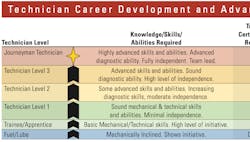The availability of equipment technicians continues to decline, rapidly intensifying the need to address recruitment, advancement, and retention of mechanically talented men and women to fill the void. Many journeyman technicians with decades of knowledge and experience are contemplating retirement or a transition to a position of lesser physical intensity. Simultaneously, younger generations are not entering the equipment maintenance industry as a primary career choice.
Reacting to generational education choice, many institutions have adjusted curricula to focus on areas of study that have increased enrollment and demand rather than on equipment maintenance or mechanical careers. Labor forecasts and statistics concur that technician availability will continue to decline, increasing the competition for qualified technicians and diesel mechanics. Truck, bus, automotive, and equipment dealers, along with government and contractor fleets, all recruit from the same diminishing talent pool. Compounding the issue is the rapid advancement of equipment sophistication that requires highly trained technicians to properly service, repair, and maintain the high-technology machines utilized today.
A succession plan is needed for equipment technicians
Most organizations maintain a succession plan for key roles and positions within the organization to ensure sustained effectiveness. A similar plan should be in place for technicians. Equipment managers actively recruit individuals from a variety of schools, institutions, and sources to meet the need for technicians. They create intern and apprentice positions to onboard and employ mechanically and technically inclined individuals. To attract and retain future technician recruits, however, as well as advance and retain existing technicians within the organization, equipment managers must develop and maintain a structured technician career-development plan.
Want more on how to manage fleets of construction equipment? Visit the Institute.
A well-defined technician development plan identifies the skills, abilities, and developmental steps required for advancement to the next level. It is a proactive approach to sustainability of the technical workforce. It motivates new recruits to remain engaged and focused, and to acquire technical training to advance within the organization. Similarly, it motivates established technicians to maintain their position level and stature by attending advanced training that keeps them abreast of changes and advancements within the industry.
The primary incentive for technician advancement is financial gain, although many soft or associated incentives are appealing to the current younger workforce, including opportunity for growth, hierarchical stature within the organization, and job security. Additionally, this group measures an organization’s investment in a sustained developmental and advancement plan to retain, develop, and advance technicians. Having a creditable plan significantly increases the likelihood that younger technicians will establish a long-tenured career within the organization.
A well-defined technician development plan provides a proactive approach to sustainability of the technical workforce
The organization benefits through continued cost-effective and efficient equipment maintenance services and the preservation of institutional knowledge held by existing journeyman technicians. Younger technicians will be motivated to maintain focus and engagement where ideas for improvement will be openly introduced, tested, and implemented to increase maintenance efficiency. Over time, equipment managers will be able to clearly identify individuals who excel. Those with the initiative, talents, and skill set will be available to advance into supervisory and possibly even a leadership role within the organization.
Key factors in an equipment technician advancement plan
Key factors in the plan are the knowledge levels, skills, abilities, and training (certification) required to identify the technician levels. Industry tenure that new and existing technicians must have within the industry and competitive compensation per level should be carefully examined and included.
The various types of assets and equipment within the organization necessitate the identification of skills, abilities, training certifications, and tenure levels for each equipment type. Position descriptions for all technical positions within the maintenance function should be reviewed for accuracy and relevance. Emphasis should be given to include all shop and field service technician positions, including fuel attendants and other support personnel. Field service potential should be identified by documenting a technician’s independence applicable to the specific technician level.
Each organization will have a varying number of technician levels within its developmental plan. Technician advancement levels should be developed to be challenging yet achievable, inspiring technicians to advance within the organization or maintain their hierarchical stature. There should be little overlap between the various technician levels as each subsequent level should be capable of performing the work of the previous level.
The table shows how technician levels progress.
Knowledge, ability, and skill requirements should relate directly to the position descriptions for each level. They should be ascending and include an independence identifier to indicate potential field service capability.
Training certifications should ascend in direct proportion to the skill set required within the specific position descriptions. Applicable training includes course study and testing to meet industry standards such as OEM-specific advanced training courses, ASE certifications, or a test score of 90 percent in a specific area such as hydraulics. The plan policy should address training and certification costs.
In this example, industry tenure requirements allow younger recruits to achieve journeyman level in six to eight years. A technical school degree or higher education degree may be considered to offset some tenure year requirements and allow advanced placement.
Compensation should be competitive, well-aligned, and sufficient to inspire technicians to advance within the organization. An hourly incentive stipend should be included per advancement level further increasing initiative and retention.
New employees will be placed into the appropriate technician level classification based on their qualifications at the time of hire. In the case of an internal transfer within the organization, the skill set must be evaluated to ensure the individual is assigned to the correct technician level.
Supply and support positions require similar knowledge of technical maintenance activities. An integration process from and to these positions should be identified within the plan. This allows these individuals to advance to open technician positions and provides opportunity for journeymen technicians to move into a less physically demanding position, thus retaining their institutional knowledge.
Ascending the specific technician advancement levels is a shared responsibility. The organization establishes the skill set, tenure, and training certification requirements of each specific level. The technician establishes the speed at which the educational and training certifications are completed, dependent upon each individual’s initiative and capacity. Goals should be established within annual reviews to attain higher levels commensurate with tenure requirements. Quarterly or semi-annual review and mentoring sessions also aid in successful completion and advancement.
Highly skilled technicians are in increasingly high demand and without them an organization will struggle to remain competitive. Having a structured development plan for technician advancement and retention will help to attract and retain these technically talented individuals.






